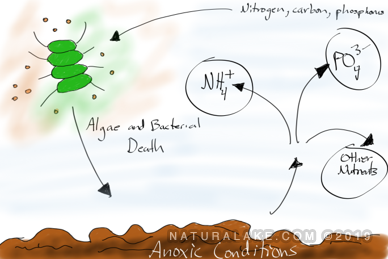Improving Traditional Treatments with a Biological Approach

Managing a lake or pond is hard for aquatic professionals, homeowners, government workers, golf course superintendents, and everyone else. Not only does it require knowledge and skill, but also choosing the proper strategy and tools. Traditionally, aquatic management strategies have been limited to two options: chemical or physical. The chemical strategy tools include herbicides, algaecides, flocculants and dyes. The physical strategy tools range from installing aeration to creating buffer zones to dredging. While the knowledge and skill to improve treatments can be acquired over time, these traditional strategies have limitations. However, there is a new biological treatment strategy available to anyone that wants to improve treatment efficiency and outcomes.
The biological aquatic management strategy focuses using all-natural technologies to treat lakes and ponds by working with the aquatic ecosystem instead of against it. The biological treatment strategy tools include both probiotics and biocatalysts. Probiotic products for lake and pond management are enhanced with beneficial bacteria and select stimulants that are designed to enhance the natural microbial communities. They come in powder, liquid and pellet forms. Biocatalyst products for lake and pond management can be composed of enzymes, cultures, fungi, micronutrients, or select stimulants. They come in powder, liquid and tablet forms. A biological treatment strategy works well when used alone, but they also do a great job at improving traditional strategies when used simultaneously.

Probiotic Advantages
- Improve water clarity
- Degrade organic debris or muck
- Reduce the excess nitrogen and phosphorus in the water column and sediment layers
Biocatalyst Advantages
- Speed chemical reactions or adhesion
- Increase penetration or chemical uptake
- Aid in fully digesting dead aquatic plants and algae
Probiotics often can and should be applied when using chemical or physical tools to improve treatment outcomes. For example, building a buffer zone (physical tool) limits the amount of nutrients a lake or pond will receive in the future, but fails to address the nutrients, nitrogen and phosphorus, already in the water body that feed algae and aquatic plants. Applying a probiotic pellet will reduce the muck and internal nutrient reservoir on the bottom of the lake or pond and applying a liquid or powder probiotic improves water clarity and removes soluble nutrients already in the water column. Another example is using a probiotic after an herbicide or algaecide treatment (chemical tool). Herbicides and algaecides can kill the aquatic plants and algae that have infested a water body. However, they also reduce the abundance and diversity of the natural microbial communities responsible for digesting organic debris and cycling the excess nitrogen and phosphorus. Applying a liquid or powder probiotic following the chemical treatment rebalances the aquatic ecosystem and promotes a rapid recovery of the microbial community.
Biocatalyst treatments also often can and should be applied to improve treatments when using chemical or physical tools. For example, hard water reduces the amount of contact a copper algaecide (chemical tool) has with algal cells by rapidly taking the copper molecules out of solution. This limits the ability of the copper algaecide to control the algae bloom. Mixing a biocatalyst in with the copper algaecide treatment speeds the chemical reactions and enhances the intercellular movement of the copper algaecide which increases efficiency and effectiveness. One more example is applying a biocatalyst after a mechanical harvesting or cutting treatment (physical strategy). Aquatic plant or weed harvesters are commonly used in lakes or ponds to cut vegetation in an approach that is like a lawn mower. Dead vegetation and organic debris can be left on the surface of the water after being cut and eventually will sink to the bottom and contribute to the muck layer. Applying a biocatalyst over the floating dead vegetation breaks down the rigid cellular framework and rapidly decomposes the dead aquatic plants to prevent them from becoming part of the muck and internal nutrient reservoir.
Using probiotics and biocatalyst technologies is an easy way to make lake and pond management more effective and sustainable. The biological treatment strategy is all-natural, environmentally friendly, and harnesses the power of existing lifecycles. Combining this with traditional treatments will significantly improve treatment efficiency and outcomes and make every lake or pond happier and healthier.



